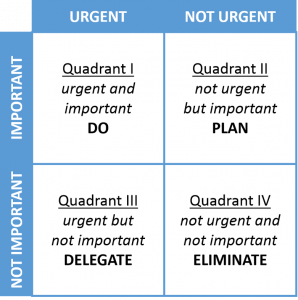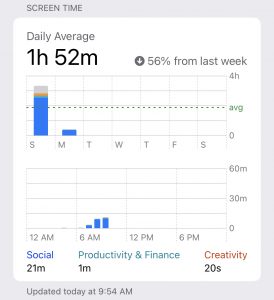Lean East writes about Lean and continuous improvement topics and we have previously summarized Stephen R. Covey’s bestseller The 7 Habits of Highly Effective People. It was only a few weeks ago that some of the similarities between Covey’s principles of time management and Lean thinking became clear to me.
Covey’s Time Management Matrix
I was leading a strategic planning session for an organization recently and focused on having the team identify their “rocks” for the new year. Rocks are often your important, yet not urgent, “Quadrant II” activities from Stephen Covey’s time management matrix below:

Covey encourages us to prioritize and schedule our “big rocks” first to prevent our schedule from filling up with items from Quadrants I, III, and IV.
Importance and Value
Later in the strategic planning session, I introduced my client’s team to the basic principles of Lean thinking. I shared the importance of understanding your processes and differentiating between the process steps that result in what your customers value and the steps that can be eliminated.
As my client identified process wastes and other improvement needs, it became clear to all of us that the Quadrant III and IV activities from Covey’s time management matrix represented some of the not-important “wastes” that should be eliminated. Lean thinking and Covey’s time management principles are quite similar!
Eliminating Wastes
Why do we all struggle with waste? We waste our effort, we waste our time, and we waste our minds on things that are not important.

The key to Lean is standardizing your processes and then, eliminating what doesn’t provide customer value – the wastes.
The key to a highly effective life is to spend your time and effort on things that provide value to your life and your goals. Everything else is not important and should be avoided or minimized.
Personal and Process Improvement
To become more Lean or more effective you will need to take the time to understand your current state.
For Lean process improvement, this requires you to observe the current process, map how it works, examine process data, and identify improvements.
For personal effectiveness, you will need to track where you spend your time and compare that to your goals.
- Where are you spending time in ways that align with your goals?
- Where are you wasting your time (and smartphones make it easy to do this)?
- Where can you develop new good habits or eliminate a few bad habits?

Be sure to examine data on how you spend your time. Here are a few simple ways:
- Use a sleep tracker to track when you wake and how long you sleep.
- Most smartphones will track your screen time, and what apps you use.
- A timesheet, task list, or calendar can track where you spend your time and what you accomplish.
Optimize Measures and Results
As you improve your processes you will have better process data and results. Similarly, as you optimize your time effectiveness and develop good new habits, you will get more done, improve results, and see improvements to the process data described above.
Reach out to our team or leave a comment below if you want help with the improvement process.


Related Posts
The God Complex: Why We’re All Making This One Mistake
How I am Changing the Career Advice I Give My Kids
This is Never Going to Work: Getting Lean Projects Unstuck